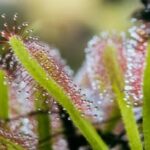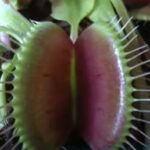As an Amazon Associate, this site earns commissions from qualifying purchases. For more details, click here.
Drosera aliciae is one of the easiest sundews to care for. Also known as the Alice Sundew, it is a lovely plant that can handle weather fluctuations better than other sundew species. This makes the D. aliciae resilient and well suited for first time growers. This guide explains the requirements to grow and care for it.
Drosera aliciae can grow in slightly to very moist soil, preferably 1:1 sand and peat. The plant needs several hours of light and prefers a temperature range between 40- 90 degrees F.
Drosera Aliciae Care Sheet
| Soil | 100% long fiber sphagnum or 1:1 perlite and peat, soil must be kept moist |
| Water | Rainwater, distilled |
| Light | 8+ hours of sunlight, indoor grow lights are fine |
| Food | Small bugs, fish food, freeze dried mealworms and bloodworms |
| Temperature | 40-90 F (4.4-32 C) |
| Humidity | At least 60% |
| Dormancy | Goes dormant if temperature is below 40 F, but it is not required |
| Propagation | Leaf cutting, division, flower stalks, root cutting, seeds |
Soil and Pot Requirements
You can use equal parts silica sand and peat for the soil. Other options are 1:1 perlite and peat or 100% LFS (long fibered sphagnum). D. aliciae have long roots so a 5 inch pot is recommended.
If you are going to use LFS you do not need to add sand or perlite. Some growers sprinkle a bit of them anyway, and it will not hurt. You may experiment with other mixing ratios like 2:1 but if you want to keep it simple go with 1:1.
Unlike Drosera rotundifolia and other sundews, D. aliciae can tolerate a drier soil. You should not let the dirt get totally dry. But the plant still grows in a lightly moistened soil. A drier media is acceptable if there is high humidity. During summer try to keep the soil very moist without overwatering.
As for the pot, the taller the better. Some Alice Sundews can grow in 3 inch containers, but taller pots allow the roots to reach their maximum potential. A 5 inch or taller container is most suitable in these cases.
Watering. Alice Sundews need less water than other drosera, but the tray method is still recommended. For a 5 inch pot, pour 2 inches of water in the tray.
Since the plant can handle a drier soil, you can keep the water level an inch lower compared to other sundew like D. indica for instance. But keep in mind Alice Sundews can also handle very moist soil. During summer keep the soil as moist as possible.
Lighting
Alice sundews require at least 6 hours of light every day. 8 to 12 hours is recommended for faster growth and you can use artificial lighting too.
Drosera aliciae colors depend on how much light and food they get. Expect reddish orange tentacles and leaves with intense light. Limited light and nutrition keeps the leaves green with an orange tint but the tentacles remain red.
If you live in a sunny location natural light will be enough. Put your D. aliciae on a windowsill (south facing recommended) and let it soak in the sun. The plant can handle up to 90 degrees F (32 C) so overheating is unlikely. If the thermometer does go over 90 degrees, partially shade your drosera.
If you want to use artificial lights for sundews, here are some tips:
- Fluorescent lights are the most cost effective. Look for 40-50W cool white bulbs or a combination of cool and warm. You can also use Sansi LED Grow Light as it is effective with carnivorous plants.
- Incandescent lights produce a lot of heat. Keep the light some distance from your sundew if you want to use this.
- Photoperiod for sundews should be 13-16 hours.
Whenever possible use natural light, but artificial lighting will also work great. You can also use fluorescent lights as a boost if natural light is limited.
Temperature and Humidity
The maximum temperature for growing Drosera aliciae is 90 degrees F. Anything higher and the plant will weaken. These sundews shrink to its roots if the temperature drops to 40 degrees. A humidity level of 60% is sufficient.
D. aliciae grows in naturally waterlogged areas, but they have greater tolerance for high temperature than other drosera. At 90 degrees the plant will not flourish but not die either. Keep the temperature under 90 degrees for best results especially in low humidity.
D. aliciae does not need very high humidity to produce mucilage (dew). A humidity rate of 60% is enough for the plant to generate dew. If the humidity drops below this, dew production will go down. Not right away, but if the humidity level remains under 60% for long, the sticky stuff will dissipate.
Use a humidifier to maintain the humidity level at 60% or higher. If you want more dew, increase the humidity with a humidifier.
As sunlight intensity increases so does the temperature. One way to protect your sundew is the previously mentioned tray method. The water seeps into the plant and keeps the humidity high enough to offset the heat.
Temperature and humidity are closely linked to light and they have a significant effect on growth. Try to keep the temperature and humidity within the given range. Provide at least 8 hours of light -natural or otherwise – and your D. aliciae will do great.
Feeding
If you have ever grown a Spoon Leaf Sundew or other drosera, the D. aliciae diet will sound very familiar. And it is very easy to feed.
Drosera aliciae eats small insects like ants, flies, spiders and gnats. Sundews will try to eat any bug small enough to fall in their trap. You can also feed mealworms to these plants.
If you bought a grown D. aliciae you do not have to feed it. Just leave the plant outdoors and its traps will draw insects. If you keep the plant indoors, you have to give it food every two weeks or once weekly.
You can choose any insect, dead or live. Cut the insect into small pieces if it is too big for your sundew. Drop the food onto the sticky stuff. The leaves will eventually close over the food and eat it. This might take some time, so do not be alarmed if it seems like your drosera is not eating. if you want to do it the easy way, just feed your plant with Amzy Appetizing Mealworms.
Nutrition is critical for drosera to grow, but do not feed more than twice or four times a month. Too much food can burn its leaves or kill the tentacles. Also try not to get any food particles into the soil. Pick up the spilled bits or if there is a lot, sprinkle water so hopefully it flows down and out of the soil.
Dormancy and Flowering
These sundews do not need dormancy. You can grow the plant indoors the entire year using the same care instructions given here.
Keep in mind that D. aliciae will shrivel to its roots during frost, though it will grow again during spring. The plant does not need dormancy, but it will enter a dormant-like state if it gets cold enough.
Keep this in mind if you want to grow Alice Sundews outdoors. A simple solution is to bring the plant indoors. Use artificial light and then bring it back outdoors in spring
Drosera aliciae produces several flowers. Each carries plenty of seeds. It takes a while for these sundews to bloom but you do get large amounts of seeds for propagation.
Propagation
D. aliciae is self pollinating and can be propagated four ways; leaf cutting, flower stalk cutting, root cutting and seed growing.
Growing D. aliciae from seeds is straightforward. Collect as many seeds as you want from its flowers and cultivate them. These seeds do not need cold stratification.
Growing from leaf cuttings is easy. Make sure the plant is healthy enough and the cuttings are placed in distilled or purified water. Feed the plant as soon as dew starts forming on the leaves. Both leaf cuttings and seeds benefit from strong artificial light and a 13-16 hour photoperiod.
Root cuttings and divisions are easy to do. Drosera aliciae has long, thick roots that make cutting simple. If you want to propagate sundews with flower stalk cuttings, use the same method as you would with leaves. Cut the flower stalk and place it in water.
Conclusion
There are so many drosera species to choose from that deciding what to buy can be daunting. But for beauty and ease of growing, it is hard to beat the Alice Sundew. If you are new to carnivorous plants, this is as good a plant to start with as any.

My fascination with carnivorous plants began many, many years ago with Venus Fly Traps. Now I am more than happy to impart what I know with other enthusiasts and those who are curious about meat eating plants.



